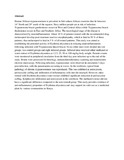Erythrina abyssinica prevents meningoencephalitis in chronic Trypanosoma brucei brucei mouse model.

View/
Date
2014-01Author
Nasimolo, J
Kiama, SG
Gathumbi, PK
Makanya, AN
Kagira, JM
Type
ArticleLanguage
enMetadata
Show full item recordAbstract
Human African trypanosomiasis is prevalent in Sub-sahara African countries that lie between 14° North and 29° south of the equator. Sixty million people are at risk of infection. Trypanosoma brucei gambesience occurs in West and Central Africa while Trypanosoma brucei rhodesience occurs in East and Southern Africa. The neurological stage of the disease is characterized by neuroinflammation. About 10 % of patients treated with the recommended drug, melarsoprol develop post treatment reactive encephalopathy, which is fatal in 50 % of these patients, thus melarsoprol is fatal in 5 % of all treated patients. This study was aimed at establishing the potential activity of Erythrina abyssinica in reducing neuroinflammation following infection with Trypanosoma brucei brucei. Swiss white mice were divided into ten groups, two control groups and eight infected groups. Infected mice received either methanol or water extract of Erythrina abyssinica at 12.5, 25, 50 or 100 mg/kg body weight. Parasite counts were monitored in peripheral circulation from the third day post infection up to the end of the study. Brains were processed for histology, immunohistochemistry scanning and transmission electron microscopy. Following infection, trypanosomes were observed in circulation 3 days post-infection, with the parasitaemia occurring in waves. In the cerebrum, typical brain pathology of chronic trypanosomiasis was reproduced. This was exhibited as astrocytosis, perivascular cuffing and infiltration of inflammatory cells into the neuropil. However, mice treated with Erythrina abyssinica water extract exhibited significant reduction in perivascular cuffing, lymphocytic infiltration and astrocytosis in the cerebrum. The methanol extract did not have a significant difference compared to the non-treated group. This study provides evidence of anti-inflammatory properties of Erythrina abyssinica and may support its wide use as a medicinal plant by various communities in Kenya.
Citation
Metab Brain Dis. 2014 Jan 23Publisher
University of Nairobi
